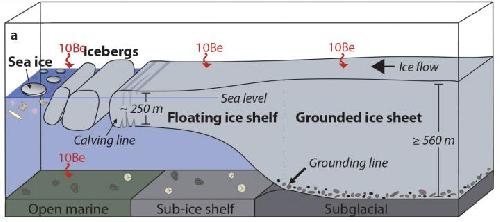While there is speculation and numerical estimates about what might happen to Antarctica's nation-sized Ross Ice Shelf in a warming climate, oceanographers have a good idea of what happened to a 100,000-square-mile section within 1,500 years after the last Ice Age ended.
The Ross Ice Shelf is a vast floating extension of the West Antarctic Ice Sheet, about the size of France, and the world's largest ice shelf. But it was once much larger, extending farther north and covering the entire Ross Sea. The present Ross Ice Shelf is about 500 miles wide and several hundred feet thick. Because the ice shelf is already floating, its breakup and melting would not pose a risk of raising global sea level.
A study in this week's Proceedings of the National Academy of Sciences details how the ice shelf shrank during a period of climate warming following the ice age.

While people typically think of continents as landmasses that rise above the sea, the margins of all continents, including Antarctica, extend well beyond their shores to include continental shelves, sub-sea aprons that are far more shallow than the deep ocean abysses that mark the continental boundary.
In western Antarctica, the Ross Sea is characterized by a continental shelf that extends nearly 1,000 miles from the coast and is as much as 3,500 feet deep. Anderson said the geologic record shows that as recently as 18,000 years ago the entire Ross basin was filled with ice that was so thick and heavy it was grounded on the sea floor all the way to the edge of the continental shelf.
"We found that about 10,000 years ago, this thick, grounded ice sheet broke apart in dramatic fashion," said Rice University oceanographer John Anderson. "The evidence shows that an armada of icebergs -- each at least twice as tall as the Empire State Building -- was pushed out en masse. We know this because this part of the Ross Sea is about 550 meters (1,804 feet) deep, and the icebergs were so large and so tightly packed that they gouged huge furrows into the sea floor as they moved north."
The Ross Ice Shelf appeared after the breakup of the ice sheet. An ice shelf is the floating, seaward extension of an ice sheet and marks the point at which the ice is thin enough to float. The grounding line is the location where the ice actually sits on the sea floor. Following ice-shelf break up, the grounding line is left exposed to marine processes, such as ocean warming, which can erode the grounding line and cause it to move back toward the shore.
The retreat was halted when the grounding line reached a series of shallow banks that acted as anchors and stabilized the ice shelf for about 5,000 years.
Anderson said, "Throughout this period, the ice shelf was pinned atop these shallow banks. On the surface, ice still covered large portions of the Ross Sea, but there was open water beneath the ice shelf."
The researchers know the times when the sea floor was partially or fully ice-covered, thanks to painstaking geochemical analyses of sea floor sediments that were overseen by study lead author Yusuke Yokoyama, a professor at the University of Tokyo. The geochemical analyses also relied on evidence gathered by the Palmer, which is capable of drilling and recovering sediment cores from the sea floor. Such cores contain a geological record that can extend thousands of years, and Yokoyama's team used Ross Sea core samples that were recovered during a 1999 Palmer cruise as well as 2015 cores and sea floor imagery to pinpoint the timing of the ice-shelf breakup.
"The really big breakup began around 3,000 B.C.," Anderson said. "We believe it was similar, in many respects, to the breakup of the Larsen B Ice Shelf in 2002. The Larsen is far smaller than the Ross Ice Shelf, but satellite imagery that year showed the Larsen dramatically breaking apart in just a few weeks. We believe the large breakup of the Ross Ice Shelf occurred at roughly this same pace, but the area involved was so much larger -- about the size of the state of Colorado -- that it took several centuries to complete."
By 1500 B.C. the breakup had exposed about 100,000 square miles of the Ross Sea that had been either wholly or largely ice-covered for many millennia, Anderson said.
To pinpoint the timing, Yokoyama's team used two novel geochemical approaches: measurement of the isotope beryllium 10, which forms in the atmosphere and does not fall to the sea floor beneath ice shelves, and "compound-specific radiocarbon dating," a painstaking technique that involves identifying and ascertaining the age of specific organic molecules in sediments. Yokoyama said each compound-specific radiocarbon dating measurement took several weeks to perform, and more than a dozen were needed for the study, which marked the first systematic use of the technique in Antarctic science.
"Our radiocarbon dating work alone took more than a year to complete," Yokoyama said. "The results of those tests, as well as the beryllium tests, provided conclusive evidence that the main breakup of the ice shelf occurred between 5,000 and 3,500 years ago."





Comments